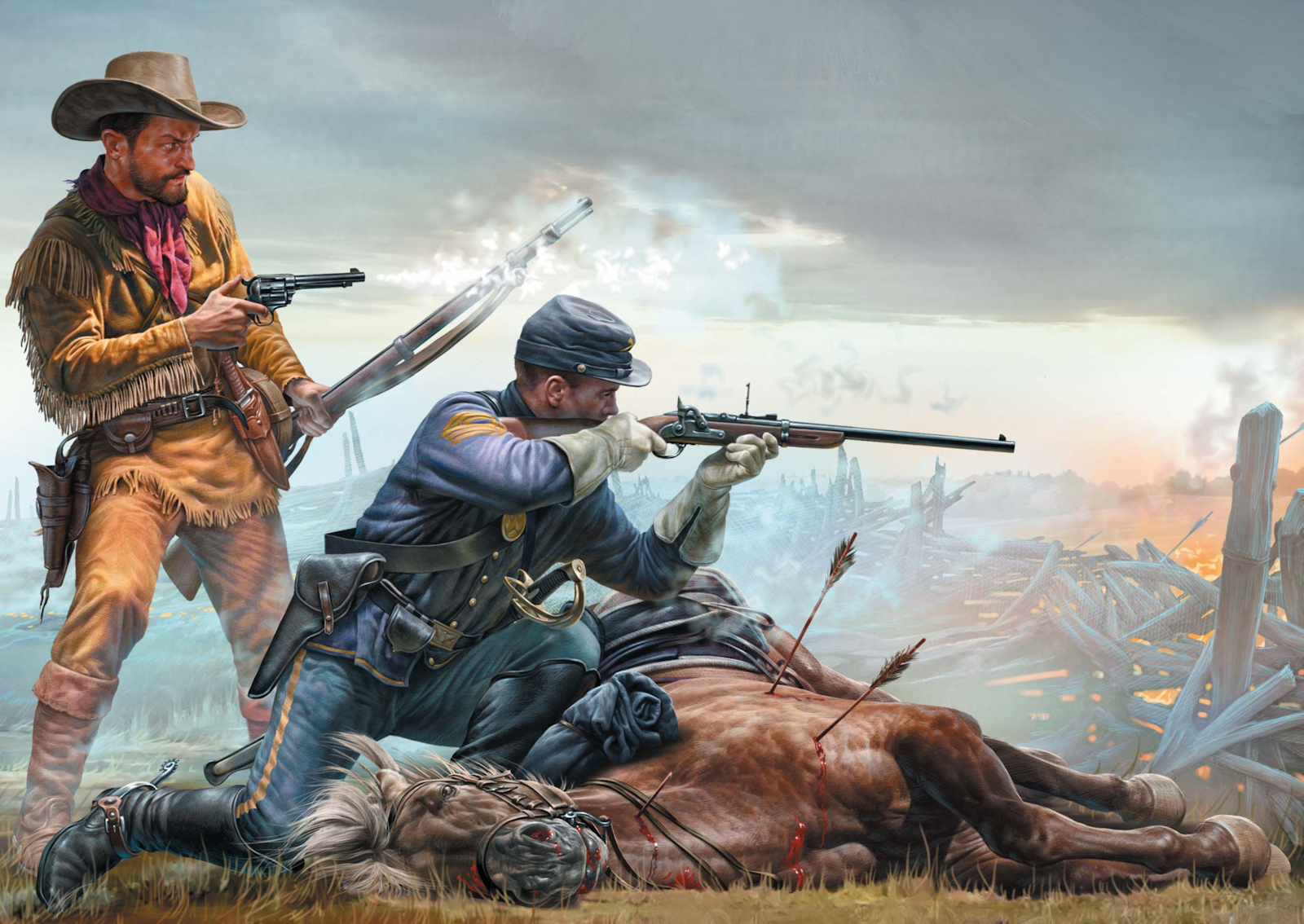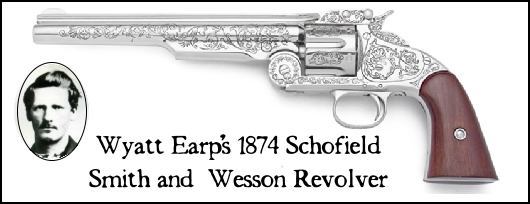
Now I am a little more confused than usual. Especially when it comes to this issue.
 Now I get it that Hollywood thinks that it’s the Winchester 73. Fair enough says I!
Now I get it that Hollywood thinks that it’s the Winchester 73. Fair enough says I!
Or how about the Mountain Men and their various Muzzle Loaders?
But then the US Cavalry might say that the Colt SAA or the Springfield Trapdoor Rifle is it.
Or the Buffalo Hunters might say that the Sharps Rifle might be it.
But then Wyatt Earp and Friends might say it’s this!
or this
But then the Indians / Native Americans would say “Hey how about our various Guns?”
See why I am confused? So what are your thoughts on this matter?
OMG!


Using a custom rifle chambered in .408 Cheyenne Tactical, Bill Poor connected on a 3-mile shot to set what could be a new world record.
Bill Poor, of Tuscola, Texas, reportedly connected on a 3-mile shot Jan. 14, 2018 near Midland. His 5,280-yard shot breaks the unofficial record of 2.84 miles (5,000 yards) set by retired Navy SEAL SEAL Charles Melton in Sept. 2017. And, it shatters the 3,800-yard and 4,210-yard shots the Hill Country Rifle Team made in 2015 and 2016.
Poor used a custom rifle modified by Vestal’s Custom Rifles, chambered in .408 CheyTac, firing a 390-grain bullet at 3,160 feet per second. It took the bullet over 14 seconds to reach the target 3 miles away.
Specifically designed for long-distance shooting, Cheyenne Tactical cartridges are popular among long-distance marksmen. Charles Melton also used a .408 CheyTac to make his 2.8-mile shot last year, and the HCR Team used a .375 CheyTac for both of their epic shots.

It reportedly took Poor just eight attempts to hit a 53-inch-wide target when he made his 3-mile shot.
I don’t care who you are, that is some extremely impressive shooting. Unfortunately, the Guinness Book of World Records likely won’t recognize Poor’s record-breaking shot. Apparently, they don’t recognize any shooting records made with optics.

Even so, by making that incredible 3-mile shot, Bill Poor has likely cemented a spot for himself with the top marksmen in the world.
Poor may not have long to hold the record for the longest-distance rifle shot, though. Charles Melton has announced he’ll be attempting a 6,000-yard (3.4 miles) shot soon.
Stay tuned to see how things go.
Like what you see here? You can read more great hunting articles by John McAdams on his hunting blog. Follow him on Facebook The Big Game Hunting Blog or Twitter @TheBigGameHunt.

























The .44 Hand Ejector Third Model, or Model of 1926, was first made in 1926 and was manufactured exclusively for Wolf and Klar of Fort Worth, Texas. It was one of the first large distributor specials produced by S&W.
In 1937, S&W added a notation to their catalog indicating that the .38/44 Heavy Duty was available in .44 Special, but it wasn’t until 1940 that the company began referring to it as the .44 Hand Ejector Model of 1926. Production ceased in 1942 and started back up again after the war.
The post-war models had an improved hammer block, and were given an “S” prefix in their serial number. A target model was also produced after 1946 with a ribbed barrel and adjustable sights.
The third Model was replaced in 1950 by the 4th Model, or Model of 1950, which later became the Model 21. Only 1473 of the transitional post-war models were made between 1946 and 1949, making this revolver very rare.
California is No Place for the Middle Class
Easy money translated into a utopian view of living. Higher taxes were a small price to pay for the psychological reassurance that a millionaire was still liberal.
Professions of abstract progressive piety make guilt-free grasping materialism possible. I suppose if you make $800,000, having your legislature outlaw dogs chasing bears and bobcats instead of building a reservoir makes you feel as if you make $80,000.
California is no place for the middle class. It lacks the tastes of the new wealthy and the romance of the distant poor, and clings to the pretensions that families of five and six should enjoy good schools, still be able to buy a house, and pop into the SUV on Sunday for an easy drive to the beach or mountains.
I drove home from Stanford after walking down University Avenue, ground zero of the Stanford-Silicon nexus. A strange, wheeled contraption with a screen followed me down the sidewalk, asking me questions with the image of its human operator in a store nearby.
Five hours and 170 miles later, I pulled into the old farmhouse, mostly unchanged since 1880—but first passing the compound of my neighbor and his cobbled together corral of sheep, goats, chickens, and geese, three broken trailer apartments, a Winnebago on blocks duplex, and a half-dozen wrecked cars amid a flock of unleashed pit bulls.
The swat team swarmed another neighbor’s “enterprises” last week, but that is another story altogether.
In California, the postmodern and the premodern are but a few miles apart.
.jpg_thumbnail0.jpg)
.jpg_thumbnail0.jpg)
.jpg_thumbnail0.jpg)
.jpg_thumbnail0.jpg)
.jpg_thumbnail0.jpg)
.jpg_thumbnail0.jpg)
.jpg_thumbnail0.jpg)
.jpg_thumbnail0.jpg)
.jpg_thumbnail0.jpg)


































They are called Super Grade for a Reason!



























Any Ideas out there?
Several weeks before the 2018 SHOT Show, Franklin Armory, who are known for their binary triggers, teased us with a picture of what appeared to be a non-NFA short-barreled rifle (SBR).
Offering scant details, the Nevada-based company said that the firearm was not, in fact, an SBR, short-barreled shotgun (SBS) nor an any other weapon (AOW).
The firearm did not require a Tax Stamp and did not fall under the red tape of the National Firearm Act. This started a frenzy of speculation, as bloggers and journalists tried to figure out exactly how the Reformation was getting around the NFA.

To get maximum accuracy from the Reformation, you need a special projectile equipped with a fin. It functions similar to the fin on a dart.
On the first day of SHOT Show, Franklin Armory held a press conference at their booth where they explained the legalities of the Reformation. Since shotguns have a smooth bore, and rifles have a rifled bore which imparts spin on a projectile, Franklin Armory opted for neither and instead cut straight lands and grooves.
Straight lands and grooves do not impart spin on a barrel. Therefore the Reformation is not a rifle. In their press release handed out during the presentation, Franklin Armory claimed the Chief of the ATF’s Firearm Technology Division confirmed that a firearm with a stock and straight cut lands and grooves is neither a rifle nor a shotgun, but defined as a “firearm.”
So what do you shoot through it?
To achieve a modicum of accuracy, Franklin Armory developed a fin stabilized round that Franklin claims will hold, “near MOA.” Conventional ammunition will hold 4-5 MOA at 100 yards.
Impression
What do I think of the Franklin Armory Reformation? B+ for ingenuity. A+ for interpreting the National Firearm Act, and D+ on price.
The Reformation with Franklin Armory’s BFS III trigger has an MSRP of $2,094. A Reformation without the BFS III trigger will have an MSRP of $1,679.
Seriously guys? For $1,679 I can build a military grade short barreled rifle or pistol and have enough money left over to pay the tax stamp and purchase a solid optic or mid-range suppressor.
Anyways, the Reformation should be available in Q3. The Franklin representative stated that his company was working with the industry to bring those specialty rounds to market. For more information, make sure to visit FranklinArmory.com.





